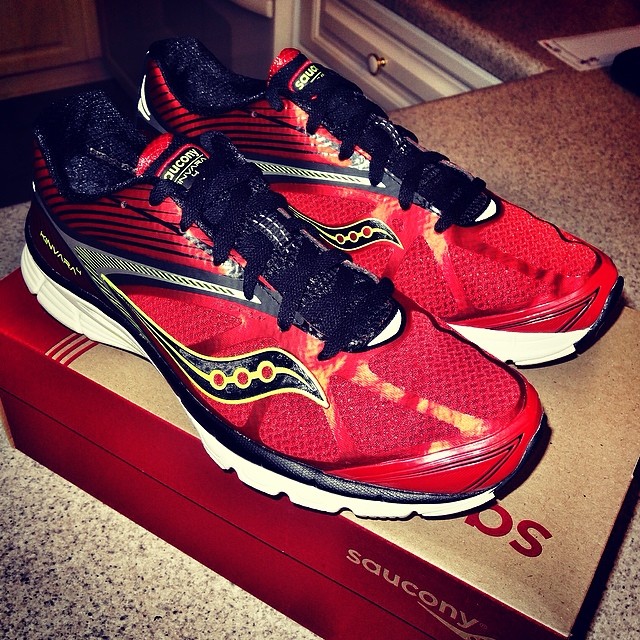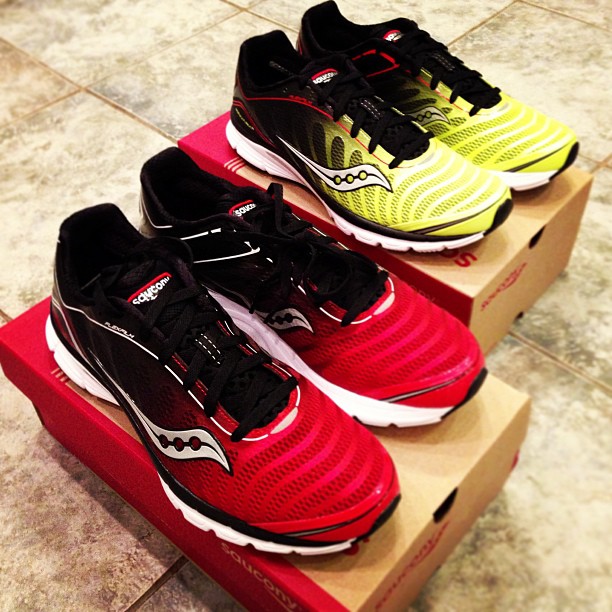Instagram filter used: Ludwig
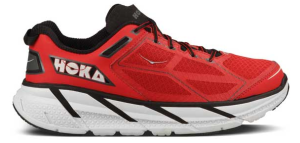
Updated – Current Running Gear (Timothy)
It’s been a LONG time coming, but I finally updated my running gear page with my current shoes and accessories. The biggest change has been the transition from 100% Saucony shoes to incorporating the HOKA ONE ONE Clifton into my training shoe rotation. I am currently without a go to trail shoe, but hope to remedy this in the next month or so as prime trail-running time arrives.
Am I Dreaming?
There are two main features I prefer in running shoes:
1.) That they be Saucony
2.) That they be RED
However, I’ve never been able to get my training shoe, zero-drop shoe, and trail shoe all in RED at the same time. Well, it looks like that might be about to change!
Kinvara 4
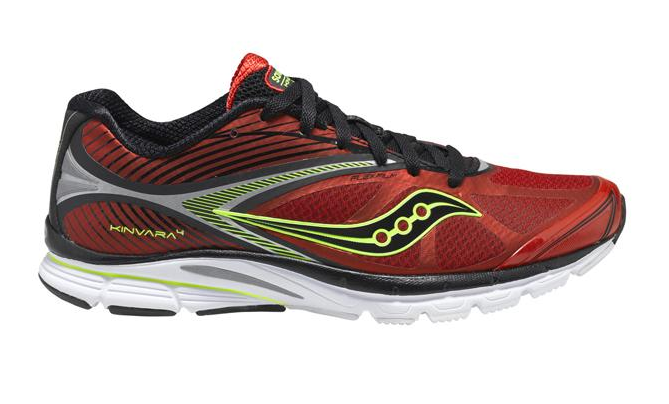
I am down to my last 2 pair of Kinvara 3s, so I should be ready for the 4s in about a month or so. Definitely going for these babies in Red and Citron!
Virrata
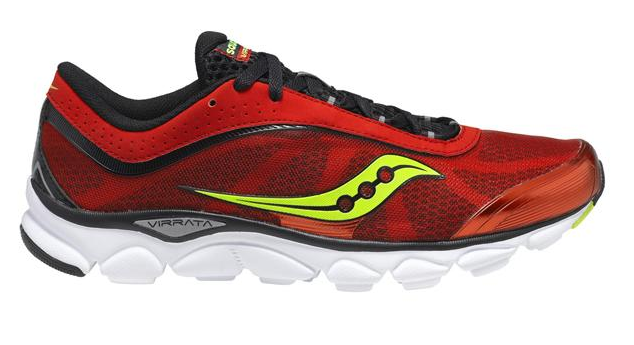
Since it looks like Saucony is going to do away with the zero-drop Hattori that I’ve been using for the past two years, I may give the Virrata a try. If so, this colorway looks about perfect! They are supposed to be released later this month.
Peregrine 3

I’ve been running in the very first Peregrine trail shoes for the past 2 years, and it is about time for a replacement. Just found out that later this summer they are going to release the Peregrine 3 in Red and Citron! Yeah Baby!!
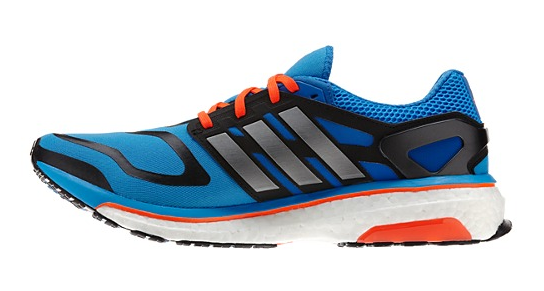
While I was on the bench from running, recovering from the stress reaction in my left femur, I made the decision to introduce a more cushioned shoe into my rotation to try and reduce the impact on my legs. My normal training and racing shoe for the past 2+ years has been the Saucony Kinvara, which I love, but I was worried that this was not providing enough protection, especially on runs greater than 10 miles. After doing a lot of research, and trying them out at Fleet Feet, I finally settled on the adidas Energy Boost.
Adidas has put a lot of marketing dollars behind this shoe, which has generated a lot of hype regarding their new mid-sole “Boost” material. Instead of using traditional EVA foam, their “Boost” technology utilizes TPU (Thermoplastic Polyurethane) that is comprised of 2,500 little plastic pebbles fused together with steam and pressure. Adidas claims this material provides “industry-leading energy return,” maximum cushioning, and increased durability that will not be compromised in extreme cold or hot conditions like EVA foam.
My first reaction was to think this was little more than a marketing gimmick, but many of the early reviews pushed me toward giving this shoe a shot. Runner’s World named it the “Best Debut” in their 2013 Spring Shoe Guide, and their shoe lab noted that the midsole had the most energy return of any shoe they had ever tested. They also rated the heel cushioning at 99 out of 100, and forefoot cushioning at 82 out of 100, yet the shoe still weighs less than 10 oz. Here is part of the report from their lab:
Adidas made lofty claims about the midsole material in its new Energy Boost shoe, including that it has “industry-leading energy return,” is resistant to temperature changes, and is more durable. But how did it fare when we put it to the test in the RW Shoe Lab? In terms of “energy return,” we can measure how much a shoe springs back–that is, how much of the energy put into the shoe on footstrike is returned on the rebound. Here, the Energy Boost truly is the industry leader: It performed better than any of the almost 800 other shoes we’d tested. Likewise, the claim about temperature resistance checked out. Typical EVA foam gets harder in cold weather and softer in hot conditions, affecting how much cushioning you experience. We tested the Energy Boost’s thermoplastic polyurethane against standard and lightweight EVA foams at 20°F and 120°F, and found it far less affected by the swings in temperature. Lab tests also indicate the foam appears to be more durable. With repetitive footstrikes, midsole material gets compacted as cell walls break down. Much of this happens early in the life of the shoe. Our tests indicated that the Energy Boost experienced half the loss of cushioning performance compared with other shoes with EVA midsoles, when mechanically loaded to simulate the first 10 miles of running.
Ultimately I coughed over the $150 to purchase the Energy Boost during the first week of my return to running program, and have put over 100 miles on this pair in the subsequent weeks. The following are my first impressions:
Fit
The fit of the upper is much more snug, stretchy, and sock-like than a traditional running shoe, and this has been a frequent point of discussion among the early adopters. I would highly recommend going at least 1/2 size up over your normal running shoe if giving the Energy Boost a try. For example, my dress shoe size is 9.5, my normal running shoe size is a 10, and I went with a 10.5 in the Energy Boost. During the first run in the Boost, I felt a little constricted in my right toes, but this subsided quickly. On all subsequent runs I found the snug fit to be extremely comfortable.
Cushioning / Ride
The cushioning of this shoe is absolutely off-the-chart, and this comes from someone who used to run in the Nike Vomero, which is like a marshmallow. What is even more amazing is that the shoe is this cushioned, yet weighs less than 10 oz. I was initially concerned that it would be very awkward/difficult to run fast in a shoe with this much cushioning, but that is not the case at all. I really think there is something to the “energy return,” since it responds like a much less cushioned shoe.
While the ride of the Boost, generally felt good, coming from running in minimal drop shoes like the Saucony Kinvara, Peregrine, and Hattori, the 10mm drop in the Boost felt significant. Running on the midfoot/forefoot was not comfortable, and I naturally dropped back to a heel-strike.
Durability
While I can’t speak about this in great detail, after running over 100 miles in the Boost, the midsole and outsole show absolutely no signs of wear. I actually think that the upper above my big toe would wear out before the midsole on this shoe.
Major Problem
Even with all of the positive items noted above, there is one major problem with the Energy Boost, and I’m hoping that it is not happening to other runners. Once my time running got above 30 minutes in my “return to running” program, I started having significant achilles tendonitis in both ankles. Having completed 13 marathons and 13 half-marathons over the past 4 years, I’ve never once had the slightest twinge in either achilles. This was obviously quite concerning to me. I did some experimenting and found that anytime I went back to the Kinvara, my achilles would settle down. Then when I would go back to the Boost, they would immediately flare back up, even getting to the point where I was having pain in my left calf. After going back and forth for a few weeks, I have now decided to abandon the Energy Boost, at least for the immediate future. I’m not sure why this is happening, but the Kinvara just feels so much better on my ankles. I don’t know if it is related specifically to the construction of the shoe or the move to a shoe with a significantly higher heel-to-toe drop. Whatever the case, the Energy Boost has now become my most expensive casual shoe.
With all of this in mind, I cannot recommend the Energy Boost as a daily training shoe. As for trying to incorporate a more cushioned shoe into my rotation, I may give the Saucony Ride 6 a try since it is a 4mm heel-to-toe drop just like the Kinvara, and I’m very familiar with the fit of Saucony shoes.
This is the cover of the May issue of Boston Magazine. It is comprised of over 100 pairs of shoes worn by participants in the 2013 Boston Marathon. Inside the magazine are runner’s stories for 15 of the pairs, and many of the additional stories can be found on their website. This is fantastic.
Boston Magazine has an article (Behind the May Boston Magazine Cover) on their website that explains how the cover came about. Here is a brief excerpt:
Then our design director, Brian Struble, and deputy design director, Liz Noftle, came up with the concept of taking shoes worn during the marathon and arranging them so that the negative space is in the shape of a heart. For reasons I’ll explain in a moment, I knew as soon as I heard the idea that we had our concept—not just for the collection of essays, but also for the cover. In fact, I quickly realized that the stories of the runners who wore those shoes would be even more powerful than the essays we’d commissioned. We quickly changed course and settled on the cover concept and the outlines of a feature package: We’d shoot the shoes collectively to form the heart, but we’d also photograph them as individual pairs to illustrate the stories told by the runners in the package (which we called “The Shoes We Wore,” and which you’ll find in the May issue).
What an awesome idea, and amazing they were able to pull it off.

Today’s Run
My run this evening on the Harpeth River Greenway felt really, really good. Last night I was pretty tired, especially since it came after spending an hour aqua jogging in the pool. Tonight my legs felt fresh, and I had to fight to keep from running too fast. This was the second run from week one of my “Return to Running,” which includes:
- 3 to 5-minute walking warmup
- 4 x 4-minute run / 2-minute walk
- 3 to 5+ minute walking cooldown
I got in 16 minutes of running and 25 minutes of walking for a total of 3.75-miles completed. Tonight also marked my first run in the new Adidas Energy Boost shoes. In an earlier post regarding my planned training changes for 2013, I mentioned that I wanted to run in more cushioned shoes for runs 10 miles or greater. After doing a lot of research, I settled on the Energy Boost. Today I stopped by our local Fleet Feet, and they happened to have my size in stock. The sales guy said that they are selling so fast that they don’t even have any on display in the store.
Anyway, even though this run was MUCH shorter than 10 miles, I decided to have a go in the new shoes. They felt fantastic. Much different than my Kinvara, but still really, really great. I’ll write a full review once I get a few more runs under my belt.

Cross-Training
- 100 Pushup Routine >> Week 3 Push-Up Test – 35 Reps
- Pullups >> 12 Total Reps
Beast Mode…ON!


A couple of weeks ago I posted about my interest in the adidas Energy Boost, and today they officially introduced two new shoes in the Boost line, which will only be available at the Boston Marathon expo next week before they are available to the general public in the fall. I’m particularly intrigued by the adizero Adios Boost model (pictured above), which is an updated version of the current world record marathon shoe.
Per adidas
After the successful launch of Boost midsole technology with an energy return unlike any other, adidas is providing a sneak peek of the latest iterations with the unveil of the adistar Boost and adizero Adios Boost during the marathon. Limited pairs of each shoe will be available exclusively at the adidas booth at the Boston Marathon Expo before they go on sale to the public in August and October, respectively.
As another follow-up to my post where I mentioned incorporating a more cushioned trainer for long runs once I return to running….I just saw a new blog post on RunningWarehouse.com regarding the upcoming Saucony Ride 6…

Anyone who has followed my blog for any length of time knows that I’m a HUGE Saucony fan. Though I’ve never tried the Ride before, most Saucony shoes seem to fit me really well (Kinvara, Hattori, Peregrine).
In addition to looking pretty awesome, and being the perfect color, the Ride 6 is supposed to have even more heel cushioning than the 5, and is quite a bit cheaper than the Adidas Energy Boost that I also mentioned in a previous post.

I mentioned in an earlier post about my plan for a change in shoe strategy once I come back from the stress fracture. Since the beginning of 2012 I’ve used the Saucony Kinvara for all training runs, regardless of the distance. While I LOVE the Kinvara, I’m worried that it just doesn’t provide enough cushioning for my stride and foot strike on longer runs.
To that end, I plan to utilize a shoe with maximum cushioning for runs 10-miles or greater, and I am greatly intrigued by the new Adidas Energy Boost trainers that debuted last month.
Adidas has put a lot of marketing dollars behind this shoe, which has generated a lot of hype regarding their new mid-sole “Boost” material. Instead of using traditional EVA foam, their “Boost” technology utilizes TPU (Thermoplastic Polyurethane) that is comprised of 2,500 little plastic pebbles fused together with steam and pressure. Adidas claims this material provides “industry-leading energy return,” maximum cushioning, and increased durability that will not be compromised in extreme cold or hot conditions like EVA foam.
My first reaction was to think this was little more than a marketing gimmick, but many of the early reviews are pushing me toward giving this shoe a shot. Runner’s World named it the “Best Debut” in their 2013 Spring Shoe Guide, and their shoe lab noted that the midsole had the most energy return of any shoe they had ever tested. They also rated the heel cushioning at 99 out of 100, and forefoot cushioning at 82 out of 100, yet the shoe still weighs less than 10 oz. Here is part of the report from their lab:
Adidas made lofty claims about the midsole material in its new Energy Boost shoe, including that it has “industry-leading energy return,” is resistant to temperature changes, and is more durable. But how did it fare when we put it to the test in the RW Shoe Lab? In terms of “energy return,” we can measure how much a shoe springs back–that is, how much of the energy put into the shoe on footstrike is returned on the rebound. Here, the Energy Boost truly is the industry leader: It performed better than any of the almost 800 other shoes we’d tested. Likewise, the claim about temperature resistance checked out. Typical EVA foam gets harder in cold weather and softer in hot conditions, affecting how much cushioning you experience. We tested the Energy Boost’s thermoplastic polyurethane against standard and lightweight EVA foams at 20°F and 120°F, and found it far less affected by the swings in temperature. Lab tests also indicate the foam appears to be more durable. With repetitive footstrikes, midsole material gets compacted as cell walls break down. Much of this happens early in the life of the shoe. Our tests indicated that the Energy Boost experienced half the loss of cushioning performance compared with other shoes with EVA midsoles, when mechanically loaded to simulate the first 10 miles of running.
It also doesn’t hurt that I comes in my two favorite colors….Red & Yellow!
Too bad it retails for $150! Anybody have experience with this shoe?
Call Marathon Sports and ask if they will ship you a pair! Or shout out to Tumblrs running Boston!!!
Let me know if u want me to pick up a pair for you when I am at the expo!!!
I sincerely appreciate it, but my issue here is more that I don’t want to wear anything Boston Marathon related until I actually qualify for Boston. The cruel part about these shoes is that they just look so awesome!

For someone who desperately wants to run Boston, and is in love with the Saucony Kinvara, these limited edition Kinvara 4s are downright CRUEL! They will only be available at Saucony’s Boston Marathon expo booth or Marathon Sports in Boston.
Running Warehouse just posted a preview video of the upcoming Saucony Kinvara 4, which is supposed to drop in May. Looks pretty sweet. I’ll be interested to see what the new “seamless bootie” feels like.
Good question. I think moving to the Kinvara as your road shoe would make a lot of sense if you love the Peregrine.
I actually started with the Kinvara (fell in love!), and then decided to try the Peregrine after having a conversation with a Saucony rep about the similarities. The Peregrine and Kinvara are made on the same “Last,” so the fit is consistent. Also, the heel-to-toe drop is the same between the two.
I have a friend here in Nashville that got back into running last year after taking some time off. He was running a lot of trails, and hated his shoes, so I suggested he try the Peregrine. He also fell in love with them, and then moved to the Kinvara for his road shoe. He loves both of them.
Also, Nathan (who I mention in a LOT of my posts) and I both use the Kinvara as our road shoe and Peregrine as our trail shoe. I don’t think either of us have any intention of changing in the near future.
Hope this helps!
The Saucony Kinvara has been my training and racing shoe of choice since its introduction in 2010. I’ve loved every version so far, and we got our first look at the upcoming Kinvara 4 (K4) last month on the Saucony blog. Today Running Warehouse posted some new pics along with a rundown of changes and color options for the shoe that will drop in May.
Per Running Warehouse…The K4 retains many of the design elements of its successful predecessor, though a few tweaks (such as an improved upper and the addition of a PowerGrid heel insert) should make for a more enjoyable running experience. Saucony claims weights of 7.7 oz in a Men’s size 9 and 6.7 oz for a Women’s size 8.
Changes from the K3
- Revisited Upper: Overlays around the forefoot have been stripped down to increase breathability without sacrificing security, and a redesigned heel collar should reduce rubbing on the Achilles.
- Upgraded Cushioning: We expect that the switch from ProGrid to PowerGrid in the heel will deliver a smoother and more plush transition from heel to toe.
- Color Variety: The May 2013 release will consist of five colorways on both the Men’s and Women’s sides, so there should be something to suit everyone’s tastes.

Men’s Colors
- Citron/Black/Green
- White/Navy/Orange
- Blue/Black/Slime
- Red/Black/Citron
- Grey/Yellow/Black

Women’s Colors
- Purple/Pink/Citron
- White/Grey/Vizipro Coral
- Citron/Black/Pink
- Blue/Orange
- Black/Pink
What do you think? Personally, I’m excited about the changes, though I do think the new overlay pattern results in a less attractive shoe than the K3.

Today Saucony began dropping a little information about the upcoming Kinvara 4, which is set to lunch on May 1, 2013. It is obvious from the pics that there are going to be some changes to the Flexfilm overlays, which were introduced in the Kinvara 3. Otherwise it appears as though the only other significant change is to the heel insert. Per Saucony:
For the Kinvara 4, we upgraded the heel insert to our PowerGrid material, which helps to improve the cushioning level of this shoe. We’ve also adjusted the FlexFilm overlays from the Kinvara 3 to the 4. By exposing more mesh in the forefoot, we improved breathability while still maintaining great lockdown, and conversely we added more FlexFilm in the midfoot and heel area to really help frame and secure the foot through all phases of your gait.
No word yet on the weight, but the outsole appears largely unchanged from the Kinvara 3. On a purely aesthetic note, the change to the Flexfilm overlays will not allow for the dramatic designs we see today in the Kinvara 3.
What do you think?



